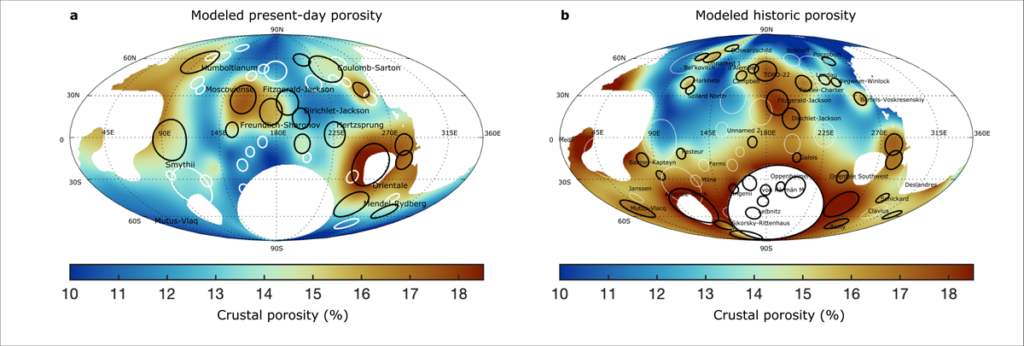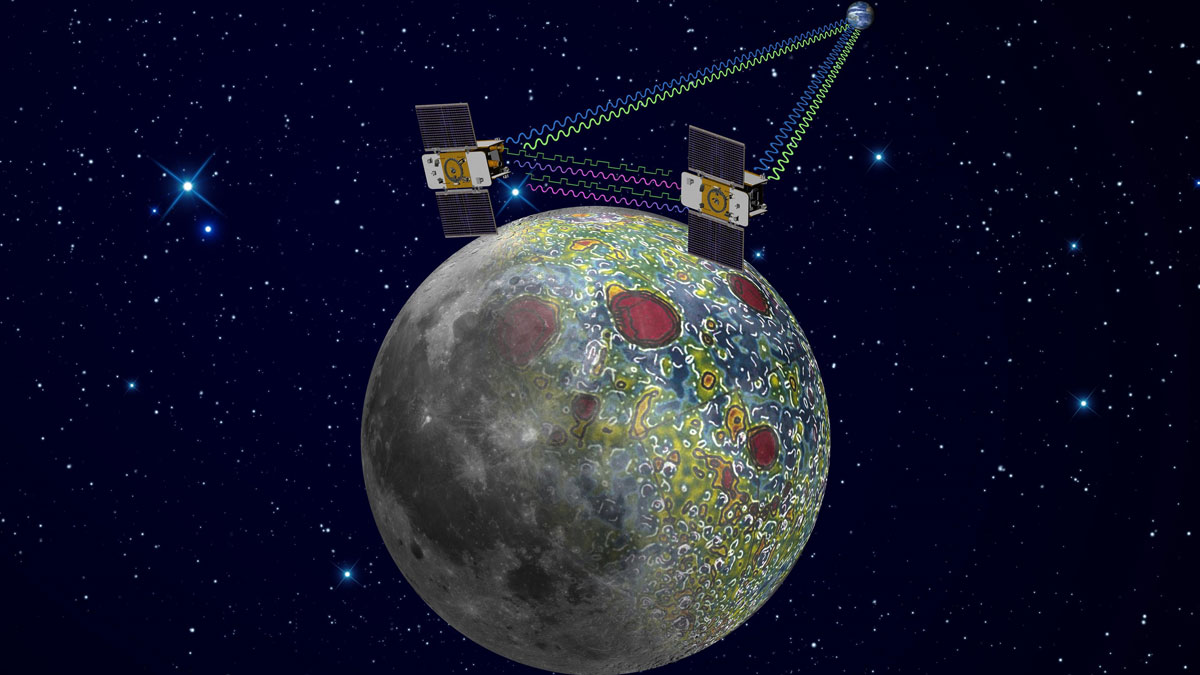The Moon’s crust has evolved from something like a croissant to something like a slice of pumpkin bread, according to a recent analysis of a decade-old data set—light and fluffy early on, but heavier and denser today. That suggests the Moon was pummeled by giant impacts early in its history but has experienced fewer cratering events than expected since then. The finding implies similar impact rates for Earth and the other inner planets, which could have influenced their early habitability.
Researchers based their work on maps of the Moon’s gravity field from NASA’s Gravity Recovery and Interior Laboratory (GRAIL), a pair of spacecraft that orbited the Moon in 2012.
“GRAIL gave us higher-precision gravity maps of the Moon than we have of Earth.”
“GRAIL gave us higher-precision gravity maps of the Moon than we have of Earth,” said David Minton, an associate professor at Purdue University and an author on the new study. “Down to spatial resolutions of about 8 to 9 kilometers, the [GRAIL] gravity field models we have are practically error free,” said Sander J. Goossens, a planetary scientist at NASA’s Goddard Space Flight Center who wasn’t involved in the study but has worked extensively with GRAIL observations.
The researchers used the gravity data to produce density maps of the crust, which reveal its porosity—the combination of voids ranging from cracks in individual grains of regolith to large faults.
New Craters Erase Older Ones
Efforts to outline the Moon’s cratering history by actually counting the craters are hampered by the fact that older features are erased when new ones form atop them. “There’s a limit to how many craters the surface can record,” said Minton. “Once craters start forming, they’re also degrading each other. You start losing the record of what was there before.”
The researchers say the GRAIL porosity maps provide a more accurate method for piecing together the cratering history.
“Our initial working assumption was that craters would slowly increase the porosity of the crust,” said team member Jason Soderblom, a research scientist at the Massachusetts Institute of Technology (MIT) who had studied the porosity of the lunar highlands in 2015. “These impacts would slowly build up the process, slowly increase the porosity over time.” The researchers began building a model to simulate how that happened.
Instead, lead author Ya Huei Huang, an MIT postdoc, discovered something unexpected: There was a big difference in the porosity around features of different ages. The surface was more porous around the youngest impact features, including basins (which generally are 300 kilometers in diameter or larger) and smaller craters, and less porous around the older impact basins, which date to as early as 4.4 billion years ago, shortly after the Moon’s birth.
The earlier impactors slammed into a relatively solid crust, fracturing it and scattering rubble far and wide. This battering action made the disturbed layers “fluffy,” with a porosity of up to 20%. But later impacts compacted the porous crust, making it denser, so today the average porosity is about 9%.

“And so rather than having this model in which impacts slowly build up porosity over time,” said Soderblom, “there’s this initial massive creation of porosity from basins…and then subsequent impacts slowly compacted that surface and brought the porosity down and down and down. And so rather than having the slow climb, it’s a spike and then a slow drop.”
That means the porosity measurements can date the relative (though not absolute) ages of impact features, Minton said, which in turn can reveal how many impacts the Moon received at different epochs. “The most heavily cratered terrains on the lunar highlands show a wider range of porosity than the less cratered regions, which have a fairly close correlation between the number of craters you see and the amount of porosity you have. So that actually suggests that the porosity really is telling us about the total impact history of the Moon.”
“The most intriguing part to me is their results for the ages,” said Goossens. “They find clusters of impacts, even earlier than the cataclysm model [of continuous early bombardment] would predict. It seems to me that this is quite intriguing. It may be that this will change when different modeling is used or more details are applied, but still. It certainly opens a venue to explore more.”
Implications for Life on Earth, Elsewhere
From the combination of porosity measurements and crater counts, the researchers estimate the early lunar cratering rate was much lower than the rates determined by some other techniques.
“We have constraints on the total number of impacts that occurred within the inner solar system,” Soderblom said, “so we have better constraints on the amount of material that has been redistributed within the solar system. That’s relevant to models in which volatiles are delivered to the inner solar system by impacts of comets and other outer solar system objects.
“On Earth we know that these types of environments would have been ideal for the formation of life.”
“The second piece of interest is this idea that the Moon’s crust and quite likely the crust of Earth and Mars and Venus were highly porous early in their evolution.…On Earth we know that these types of environments would have been ideal for the formation of life. Highly porous deep regions are protected from cosmic rays. The porosity increases the surface area for water to contact the rocks, so it will increase the rates at which chemical alterations occur, which is a source of energy for life.” Similar porosities on Venus and Mars, which probably were much more comfortable in their early days, could have enhanced their habitability as well.
None of the new generation of robotic orbiters planned for the next few years will collect better gravity data than GRAIL, Minton said. Instead, scientists may need new lunar samples—planned for both robots and the astronaut-carrying Artemis missions—to improve their picture of the Moon’s complicated cratering history.
—Damond Benningfield, Science Writer
Correction, 4 August 2022: This article was updated to correct a quote from Jason Soderblom to read “impacts slowly compacted that surface and brought the porosity down,” not the process.

